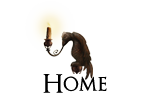Scribble City Central's thirty-third Fantabulous Friday comes from the marvellous Mary Hoffman, author of the bestselling Amazing Grace picture-books, and also of one of my favourite YA historical fantasy series - Stravaganza. I've followed Luciano and Arianna's story since the beginning, and found it immeasurably satisfying to have lots of ends tied up in the latest (and, sadly, possibly last) book, City of Swords. Mary has created the Talian world of the Stravaganti (time-travellers to a parallel Italy) with loving care, and her passion for Italy shows in the small but meticulous details hidden within her writing, not only in these books, but also in her excellent eponymous novel about Michelangelo's David. What I particularly liked, not only in City of Swords, but in all the other books in the series, is the way Mary deftly interweaves the historical derring-do with some very modern teenage problems. In City of Swords, it's self-harm, something I've seen addressed in a few YA books lately. Mary tackles it head-on, but in a sensitive way which, I hope, would encourage teenagers to talk about this very real problem. I think it's important that YA literature can sometimes act as a sort of catalyst in this way.
As far as I am concerned, Mary is the fount of all knowledge, being the person I would ask for answers about any esoteric question - especially about anything to do with Arthurian matters. I often turn to her story collection Women of Camelot for knotty problems of reference vis a vis the ladies of Arthur's Court. The Arthurian beastie she writes about here is one I love, though I first came across its fewmets in TH White's Once and Future King rather than Malory. It appears as the comical dwarf-steed Gladysant in my own Hootcat Hill, but its roots lie far back in literary history. So, over to Mary to tell you all about:
Q for Questing Beast
Hound-bellied Glatyssaunte
 |
| Photo credit: Jess Barber |
MH: Here is a range of definitions from the Oxford Guide to Arthurian Literature and Legend by Alan Lupack (OUP 2005):
“a snow white beast, smaller than a fox, and which is terrified by the yelping of a packs of twelve dogs in her belly”The source for the first descriptions is Perlesvaus, also known as The High History of the Grail, written in the early 13th century in France. The second, from the Post-Vulgate Queste del Saint Graal, dates from roughly the same date and place but is much more about a spiritual quest than it is an adventure story.
“a devil born to the daughter of King Hipomenes, who had intercourse with a devil” after her brother rejected her incestuous advances.
“the head of a serpent, the body of a leopard, the buttocks of a lion, and the feet of a hart.”
The third is from Sir Thomas Malory’s Morte d’Arthur and is where I first met the Beast (see below). It is from a century and a half later than the earlier sources and for me this is where the Questing Beast comes into her (or his) own.
In my first year of studying English at Cambridge, my Tutor for Medieval Literature set me an essay topic: “Malory, the least intelligent author ever to become a classic.” That was the way they rolled back in the ‘60s. I bought my precious copy of The Works of Thomas Malory, in the Vinaver edition, for twenty-five shillings, at a time when I had only thirty shillings a week to live on, and it rapidly became my Desert Island Book, the one I’d save first if my house was on fire.
 |
| The Vinaver Edition of Malory |
I now have three other editions, including the beautiful Aubrey Beardsley facsimile, but it’s my chubby little green Vinaver with Roy Morgan’s woodcut on the front that I reach for first when I need a Malory fix. You see that essay didn’t quite work out as Professor Spearing thought it would. Instead of finding Malory “unintelligent” or in any way overrated by posterity, I fell deeply in love.
Not the place here to count the ways, but I stumbled upon the Questing Beast in Book 1, chapter 19:
“And as [Arthur] sat so, him thought he heard a noise of hounds, to the sum of thirty. And with that the king saw coming toward him the strangest beast that ever he saw or heard of; so the beast went to the well and drank, and the noise was in the beast's belly like unto the questing of thirty couple hounds; but all the while the beast drank there was no noise in the beast's belly: and therewith the beast departed with a great noise, whereof the king had great marvel. And so he was in a great thought, and therewith he fell asleep.
Right so there came a knight afoot unto Arthur and said, Knight full of thought and sleepy, tell me if thou sawest a strange beast pass this way. Such one saw I, said King Arthur, that is past two mile; what would ye with the beast? said Arthur. Sir, I have followed that beast long time, and killed mine horse, so would God I had another to follow my quest. Right so came one with the king's horse, and when the knight saw the horse, he prayed the king to give him the horse: for I have followed this quest this twelvemonth, and either I shall achieve him, or bleed of the best blood of my body. Pellinore, that time king, followed the Questing Beast, and after his death Sir Palamides followed it.” [Caxton text]
This is very early in the story, before Excalibur, before Guinevere, before the Round Table and the Company of Knights at Camelot. Thereafter it recurs like a glinting thread in a tapestry, leading first King Pellinore and then Sir Palomides a merry dance.
 |
| The Beardsley Beast |
So it is a beast both “questing” and the object of Pellinore’s and Palomides’ Quest. For me it represents the “idée fixe,” the object that cannot be resisted. And all writers of fiction are familiar with that idea! Maybe that’s why the Beast crops up in so many later versions too? (In Spenser’s Faerie Queene it is the Blatant Beast, but that’s not a comment on its immodesty, merely another version of the “glatisant” or “questing’ noise in its belly).
He, she or it (for the Beast is as elusive as to its gender as it is in appearance) crops up in many more recent stories, from William Morris’s poem Palomydes' Quest of 1855 to Alasteir Crowley’s The High History of Good Sir Palamedes the Saracen Knight and of His Following of the Questing Beast of 1911 and T.H. White’s Once and Future King (1958).
When I told my husband that I was writing about the Questing Beast, he mentioned casually that he had cited it in a paper he had written about Charles Williams for the Anglo-American Literary Review, Vll. Duly impressed, I looked it up and it is in Vol 20 (2003) Metaphysical and Romantic in the Taliessin Poems by Stephen Barber.
Williams wrote a poem “The Coming of Palomides,” in Taliessin Through Logres (OUP 1938) at the end of which, when the knight has been smitten by the sight of Iseult, come the lines:
“I heard the squeak of the questing beast,
where it scratched itself in the blank between
the queen’s substance and the queen.”
Isn’t that fabulous? The very definition of an “idée fixe” is in that “blank between/ the queen’s substance and the queen.” (And the very definition of unrequited love, another mythical beast, to be filed under U).
The commentator (a.k.a. my husband) says “Williams makes Palomides’s endless futile quest for this beast, a standard theme in Arthurian writing, embody his obsessive and futile passion for Iseult.”
Some have speculated that the Beast coming where it does in Malory and trailing its associations of incestuous love, after Arthur has unwittingly slept with his half-sister Morgause and fathered the fatal Sir Mordred, symbolises forbidden combinations. I like that idea: that our most obsessive quests might be for the Thing that Should not be.
But actually I just rather love the Questing Beast (which for me is female). I love the idea of the prey which is constantly quested after and may not be caught, the idea that the bond between hunter and hunted remains pure only when not consummated.
Lucy asked whether I might write about her one day. Well, now that she has cropped up in the TV Merlin, (which Lucy enjoys but I cannot bring myself to watch), I’m not so sure! But I love the idea of writing about Broceliande, the enchanted forest and I’m sure that Glatyssaunte would lurk somewhere in its depths.
SCC: Thank you so much, Mary. As always, I am in awe of your erudition. I'm now reminded of how to spell Glatyssaunte properly, and you've inspired me to go and dig out my own Malory and have a browse through the forest of Broceliande.
You can find out more about Mary in the following places:
www.maryhoffman.co.uk
www.stravaganza.co.uk
http://bookmavenmary.blogspot.com
http://the-history-girls.blogspot.com
Twitter: @MARYMHOFFMAN
Mary is also on Facebook at: Mary Hoffman Author Page; Official Stravaganza Page; History Girls Page and Luciano and Arianna Page.
If you'd like to buy any of Mary's books mentioned in this piece, you can do so HERE
Next Week: Sarwat Chadda goes head to head with the fearsome R for Ravana. Swords at the ready, people!


















3 comments:
The Questing Beast is a parodic counterpoint to the quest for the grail (and far more enticing!) I left the beast out of my PhD thesis, which was perhaps just as well as the examiner was that same Prof Spearing who had such a low opinion of Malory in the 60s!
I had not come across the Williams poem, Mary - "in the blank between
the queen’s substance and the queen" is also, surely, the definition of the frustration of writing - that what is actually written never matches up to the initial conception. I'm sure Malory would have sympathised with that.
Thank you both for a wonderful post.
Oh, I love the idea of the Beast as parodic parallel to the Grail quest! I'm glad you liked the Williams quotation.
I think it's a good summation of the modern writer's dilemma but i think that perhaps someone in Malory's day would have been less self-conscious.
I rather admired Spearing apart from that gap in his sensibility.
Hmmn. Beast as parodic parallel? That makes sense, Anne. It seems like a perfect topic for someone else's PhD thesis - do you know if anyone has explored it? If I were doing a PhD (not ever going to happen!), I'd definitely take it on.
Post a Comment